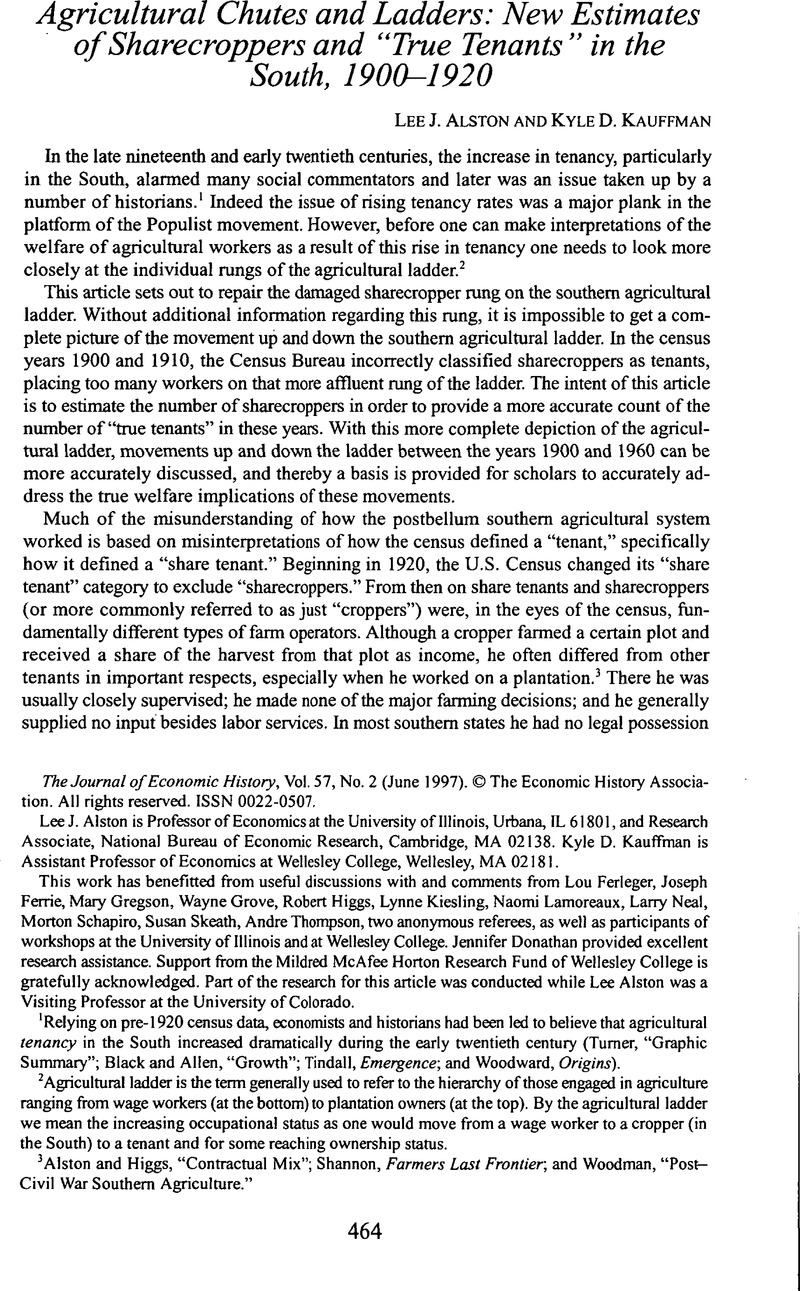Crossref Citations
This article has been cited by the following publications. This list is generated based on data provided by Crossref.
Ackerberg, Daniel A.
and
Botticini, Maristella
2000.
The Choice of Agrarian Contracts in Early Renaissance Tuscany: Risk Sharing, Moral Hazard, or Capital Market Imperfections?.
Explorations in Economic History,
Vol. 37,
Issue. 3,
p.
241.
Alston, Lee J.
and
Kauffman, Kyle D.
2001.
Competition and the Compensation of Sharecroppers by Race: A View from Plantations in the Early Twentieth Century.
Explorations in Economic History,
Vol. 38,
Issue. 1,
p.
181.
Fishback, Price V.
Kantor, Shawn
and
Wallis, John Joseph
2003.
Can the New Deal’s three Rs be rehabilitated? A program-by-program, county-by-county analysis.
Explorations in Economic History,
Vol. 40,
Issue. 3,
p.
278.
Virts, Nancy
2006.
Change in the plantation system: American South, 1910–1945.
Explorations in Economic History,
Vol. 43,
Issue. 1,
p.
153.
Gao, Yanyan
2009.
Transaction Costs in Tenancy Relationship, Fragment Level of Land Property Rights and Agricultural Development.
SSRN Electronic Journal,
Naidu, Suresh
2010.
Recruitment Restrictions and Labor Markets: Evidence from the Postbellum U.S. South.
Journal of Labor Economics,
Vol. 28,
Issue. 2,
p.
413.
CARMONA, JUAN
and
SIMPSON, JAMES
2012.
Explaining contract choice: vertical coordination, sharecropping, and wine in Europe, 1850–19501.
The Economic History Review,
Vol. 65,
Issue. 3,
p.
887.
Ramcharan, Rodney
and
Rajan, Raghuram G.
2012.
Constituencies and Legislation: The Fight Over the McFadden Act of 1927.
SSRN Electronic Journal,
Rajan, Raghuram G.
and
Ramcharan, Rodney
2012.
Constituencies and Legislation: The Fight Over the McFadden Act of 1927.
SSRN Electronic Journal,
Ramcharan, Rodney
and
Rajan, Raghuram
2012.
Constituencies and Legislation: The Fight Over the McFadden Act of 1927.
Finance and Economics Discussion Series,
Vol. 2012,
Issue. 61,
p.
1.
Wilse-Samson, Laurence H.
2013.
Structural Change and Democratization: Evidence from Rural Apartheid.
SSRN Electronic Journal,
Salisbury, Laura
2014.
Selective migration, wages, and occupational mobility in nineteenth century America.
Explorations in Economic History,
Vol. 53,
Issue. ,
p.
40.
Rajan, Raghuram G.
and
Ramcharan, Rodney
2016.
Constituencies and Legislation: The Fight Over the McFadden Act of 1927.
Management Science,
Vol. 62,
Issue. 7,
p.
1843.
Ager, Philipp
Brueckner, Markus
and
Herz, Benedikt
2017.
The boll weevil plague and its effect on the southern agricultural sector, 1889–1929.
Explorations in Economic History,
Vol. 65,
Issue. ,
p.
94.
Alston, Lee J.
and
Mueller, Bernardo
2018.
Priests, Conflicts and Property Rights: the Impacts on Tenancy and Land Use in Brazil.
Man and the Economy,
Vol. 5,
Issue. 1,
Elman, Cheryl
McGuire, Robert A.
and
London, Andrew S.
2019.
Disease, Plantation Development, and Race-Related Differences in Fertility in the Early Twentieth-Century American South.
American Journal of Sociology,
Vol. 124,
Issue. 5,
p.
1327.
Edwards, Eric C.
Fiszbein, Martin
and
Libecap, Gary D.
2022.
Property Rights to Land and Agricultural Organization: An Argentina–United States Comparison.
The Journal of Law and Economics,
Vol. 65,
Issue. S1,
p.
S1.
Feigenbaum, James
Lee, James
and
Mezzanotti, Filippo
2022.
Capital Destruction and Economic Growth: The Effects of Sherman’s March, 1850–1920.
American Economic Journal: Applied Economics,
Vol. 14,
Issue. 4,
p.
301.
Witzel de Souza, Bruno Gabriel
2023.
‘The same contract that is suitable for your Excellency’: Immigration and emulation in the adoption of sharecropping‐cum‐debt arrangements in Brazil (1835‒80).
The Economic History Review,





